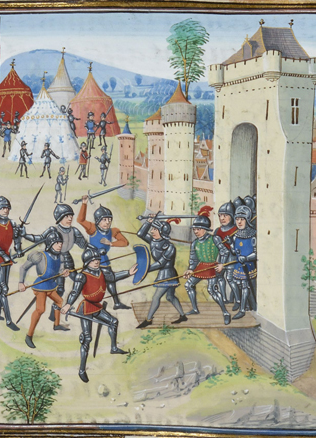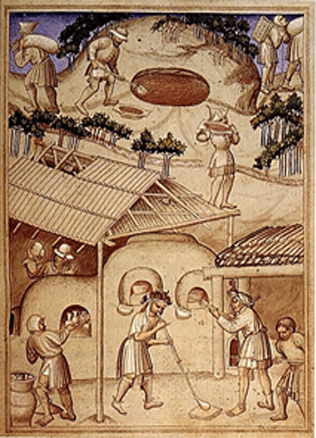Lithuania’s Oldest Writing Tools: Styluses from Kernavė
In the 13th and 14th century, a well-fortified ducal residence stood on the Aukuras Hill in Kernavė. It was there that archaeologists have unearthed some luxurious imported items that only the elite could afford as well as two writing tools – iron styluses. The styluses, used for writing on birch bast or wax tablets, often emerge in the cultural layers of that period in cities around Europe. The styluses usually were made of iron or bone and featured one sharp end for writing. Another triangle-shaped end usually was wide for erasing symbols on tablets. Pieces of iron and bone, identified as fragments of styluses, have been found in the territory of the Lower Castle in Vilnius too, but they are from the 15th century. Other styluses found in Lithuania are from even later times. In Kernavė, the styluses have been found in the cultural layer that had formed before 1390, the year when the Crusaders burned the city down. The two styluses from Kernavė are the earliest known writing tools in Lithuania. Obviously, dukes had literate people with them. Who were they? When and why did they write and what language did they use?
When did Lithuanians begin using writing tools?
Many researchers have been trying to answer a question – when did Lithuanians write their first alphabetic text? We should not look for the Lithuanian symbols of writing in prehistoric ornaments of the Balts and in signs carved in stones or in other objects that surrounded the illiterate prehistoric society. In Central and Eastern Europe, writing spread together with Christianity. It is very difficult to imagine the church practice without appropriate texts written in the language that the local people can understand. Linguists maintain that the history of the Lithuanian written language begins well before 1547 when the first printed book in Lithuanian, the Catechism by Mažvydas, was released. They suggest turning back to the years of Mindaugas’ reign in the middle of the 13th century. The fact is, however, that we do not know any written source in Lithuanian from the 13th, 14th, and even 15th century.
Written documents, as a means of international communication, must have been vital after the establishment of the Lithuanian state and especially during the Christening and coronation of Mindaugas, in 1251–1253. It is likely that German Catholic churchmen from Prussia or Livonia worked as Mindaugas’ scribes then. Historians are aware of the 1263 Russian-language treaty between Girdenis, the duke of Polotsk, and Livonia. Letters of the Gediminids are in different languages too. Gediminas’ letters to the Pope are in Latin, while these to the German Order are in German. Algirdas’ treaties with dukes of Rus’ are in Ruthenian. It is possible that Dominican or Franciscan monks helped Gediminas, while Russian Orthodox clergymen worked for Algirdas. Lithuania had no state chancellery, nor did it employ professional scribes before Vytautas became the grand duke in 1392, historians maintain. Written documents for local use became more widespread in the 15th century with the Ruthenian language finally gaining ground as the main written language.
Medieval “word processor”
It is difficult to determine the precise age of the styluses found in Kernavė, because their dating is rather appropriate and spans the broad period during which the city of Kernavė existed, i.e. from the reign of Mindaugas and Traidenis to the last Gediminid before Vytautas. It is impossible to link the styluses to any particular duke that might resided there nor to any political activity he might have carried out. Neither it is possible to determine the language used by the scribe who lost his styluses, to the archaeologists’ great joy.
Scribes used parchment and quill pens rather than styluses and wax tablets to compile important international treaties.
Writing tablets of various sizes were made of framed wood filled with wax. Some tablets had both of their sides filled with wax and sometimes people used book-like sets of several tablets. The wax surface was easy to write on, while erasing information was even easier.
Functionally, the wax tablets are somewhat resemblant of contemporary digital notebooks that enable very simple editing, erasing and rewriting of any text.
Whenever we need to make it an official paper though, we must print it out and crown it with a seal. The tradition was very much the same in Traidenis’ castle, because a literate man had to translate the ruler’s messages into a language that his addressee could understand; then he had to inscribe the text in the wax tablet using a stylus before finally putting it down on a piece of expensive parchment, his ruler already enjoying rest after the creative effort. When dispatching low-importance messages, senders sometimes expected to get a reply on that same wax tablet.
Ruthenian lands among most literate
In some lands of the GDL, scribes used styluses much earlier than their counterparts in Kernavė. Navahrudak and Volkovysk, the two cities situated at the upper reaches of the River Nemunas, yielded almost 30 styluses from the cultural layers representing the period between the 11th and 14th century. Traditions of writing spread together with the Christianity in Slavic cities.
Archaeologists have found styluses and wax tablets with surviving religious inscriptions from as early as the 10th century in Novgorod.
In addition to that, historians have more proofs of literacy – other than styluses and wax tablets – in Novgorod and in other Ruthenian cities that once belonged to the GDL. Many household items, such as ceramic vessels and bone tools, bear various inscriptions. Archaeologists have found thousands of messages inscribed on birch bast in Novgorod, and many of them have nothing to do with the ducal chancellery. Some of the messages are plain gossip against neighbours, some are dotted with harshest expletives. This indicates that a considerable part of Novgorod’s community was literate.
Notably, the long-lasting archaeological research in the Pajauta Valley in Kernavė has not yielded a single item bearing any kind of inscriptions. Scientists have found dozens of inspiring samples of bast ornamented using bone stamps, the technology known only in Kernavė. They have also found hundreds of fragments of bast-made household vessels, but without a slightest sign of inscribed letters on them. In some of the recent works, historians offer a hypothesis that Orthodox Russians lived in the researched part of Kernavė. But the absence of samples of writing is an important argument which supports the notion that Kernavė was a city inhabited by Lithuanians.
Gintautas Vėlius



